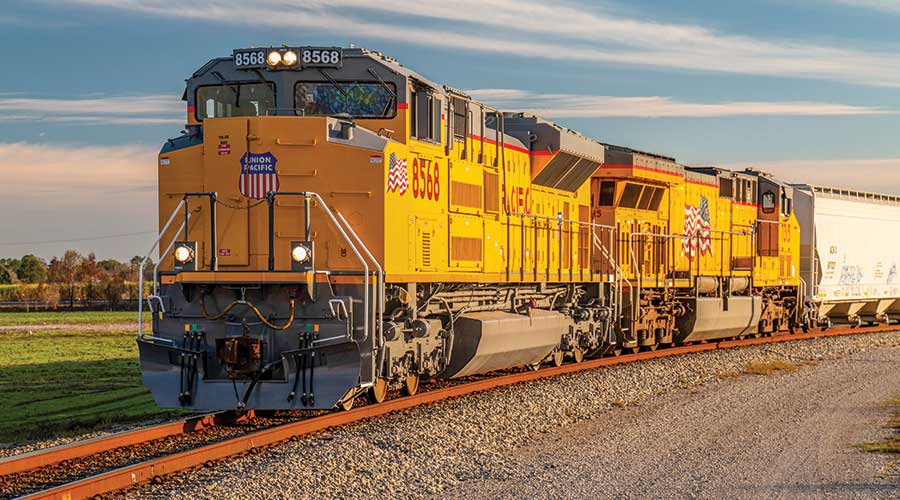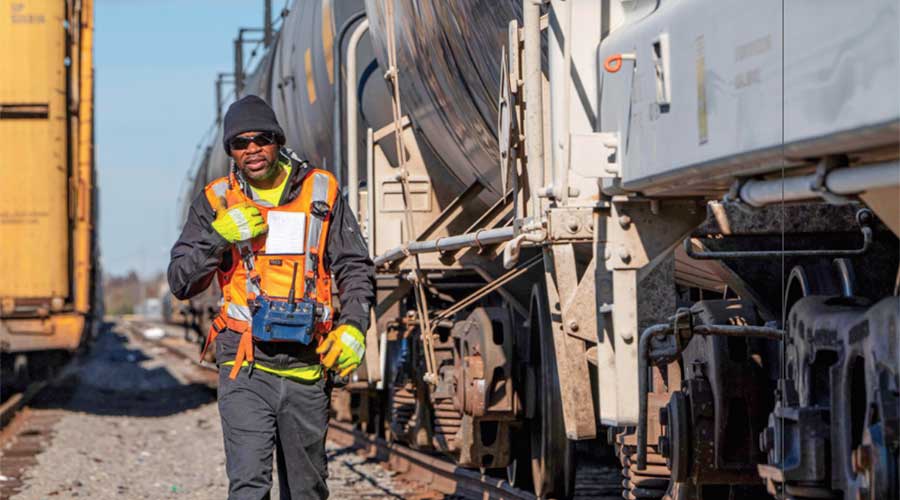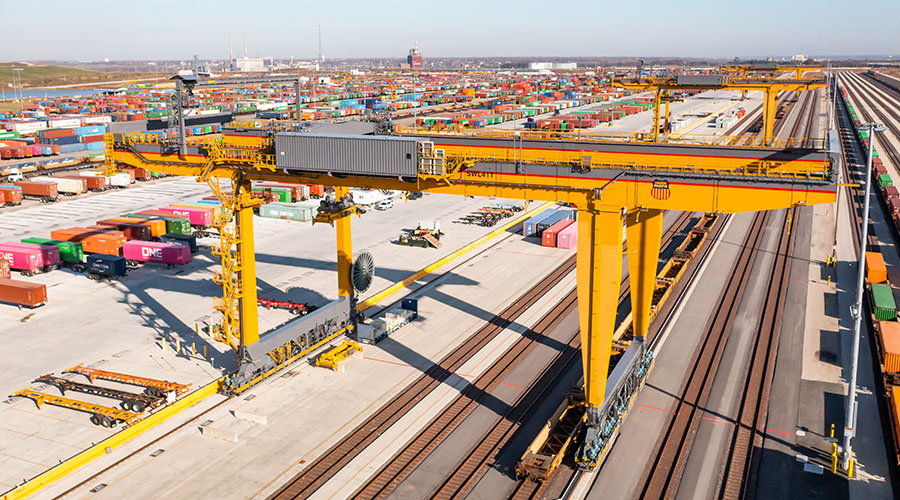Stay updated on news, articles and information for the rail industry
May 2008
Rail News: Rail Industry
Dwelling on the positive at UP's Bailey Yard
By Jeff Stagl, Managing Editor
Drive down the main road leading to Union Pacific Railroad’s Bailey Yard and you’ll pass the new Golden Spike Tower and Visitor Center. By June, the city of North Platte, Neb., will open the seven-story tower — shaped like the historic transcontinental railroad spike — to provide tourists and rail fans a bird’s-eye view of the world’s largest classification yard.
It’s impossible to fully grasp Bailey Yard’s massive scope while driving around the facility, a labyrinth of nearly 200 separate tracks totaling 315 miles, 985 switches and 766 turnouts. Even from a 95-foot-high tower across the street, you won’t be able to drink in the yard from end to end.
Named after former UP President Edd H. Bailey, the yard covers 2,850 acres — enough room for 3,097 football fields. Stretching eight miles long and two miles wide, and separated as Bailey East and West, the facility sports two humps and bowls, a diesel repair shop, car repair facility and command center.
Since its first tracks were laid in 1948, Bailey Yard has been a key terminal for UP, a major employer and economic driver for North Platte (population: 24,500) for more than 140 years. Located midway between Chicago and Salt Lake City, the facility helps keep intermodal, grain and other trains flowing toward both coasts and the Canadian and Mexican borders. Also situated halfway between Denver and Omaha, Neb., the yard ensures coal trains cycle between Powder River Basin mines and nationwide utilities.
Bailey Yard, which employs more than 2,600, is a key indicator of UP’s network fluidity. If traffic’s flowing in North Platte, it’s likely humming network-wide. The ongoing challenge for the yard’s management team: find ways to handle more volume and in less time so trains keep moving.
“We’ve already invested millions of dollars in capital improvements at the yard,” says Chad Wilbourn, UP’s general superintendent of transportation services, North Platte Service Unit, who oversees Bailey Yard. “We’re trying to make fluidity gains and reduce dwell through capacity and process improvements.”
Economic indicator
Featuring an east and west hump that classify an average of 3,600 cars a day, or four per minute, the yard handles more than 150 trains and 13,000 rail cars daily. Managers believe the facility’s high volume and broad traffic mix — ranging from corn to sugar to chemicals to lumber — also make the yard a good barometer of the U.S. economy. Although the economy has continued to be sluggish in 2008, yard traffic wasn’t soft in the first quarter.
“Our volume was a little higher than last year,” says Wilbourn. “Coal has been good and grain was the best it’s been in a long time.”
Although a typical day’s traffic also includes potatoes, fruit, steel, automobiles and other commodities, coal is king at Bailey Yard. Of the more than 150 trains and 13,000 rail cars that flow in and out each day, loaded or empty coal trains account for nearly half.
For example, the yard on April 16 handled 155 trains, of which 70 were coal, 60 were manifest, 15 were intermodal or automotive, six were grain or ores and four were local trains.
West-side story
To keep trains on the move, managers have targeted improvements at the yard’s west side, where empty coal trains stop on their way back to Wyoming mines and loaded premium-service unit trains (such as automotive, intermodal or grain) are inspected and maintained before heading west. Unit trains account for about 70 percent of the yard’s traffic.
Last month, yard managers assigned two of the west side’s 18 run-through tracks as “fast tracks,” which are used to inspect and provide fuel for unit trains needing minimal service before departure. Each day, the fast tracks will handle 15 trains, of which two or three will be coal trains.
“We’re trying to shave a couple of hours off dwell,” says Wilbourn.
The yard previously employed a first in, first out process at the west side. Now, there are two processes: the fast tracks for minimal service and typical inspection/maintenance for all other trains.
“We have an opportunity to do 10 more trains at the fast tracks in a second phase,” says Wilbourn.
Workers also are performing in-train wheel changeouts on empty westbound coal trains in the field to reduce dwell. Implemented in late 2006, the process calls for two workers to slide a hydraulic jack under the couplers between two cars and attach chains to the parts of the trucks they want to raise.
More ups than downs
After the jack elevates, another worker operates a Combilift — a forklift-like machine manufactured in Monaghan, Ireland, that’s designed to function in tight warehouse spaces — to remove the old wheelset and place a new one on the track. As the jack lowers, one worker guides the new wheelset to its proper position under the truck, and the wheelset is locked in place.
Since January 2007, the yard has devoted two three-man crews to the process, which takes about eight to 12 minutes to complete. Before, it could take 12 days to hand off a bad-order car several times to reach the yard’s shop, have a wheelset repaired and return the car to run-through tracks, says Casey Dyer, the yard’s director of mechanical maintenance. The yard also saves time by not having to switch in a fill car to keep a coal trainset intact.
“We can replace 70 to 90 wheelsets per day in the field,” says Dyer. “We’ve done 30 in one shift where we could do 30 a day in the shop.”
Last year, workers also began performing light car repairs in the field on the east side so cars don’t have to cross the yard to reach the repair shop.
“Switching time is tremendous,” says Dyer. “We want to keep cars closer to where they head out.”
In addition, workers last year installed an ultrasonic wayside detector to identify internal wheel defects and might install two more this year. In 2004, wheel set-outs averaged 34 per day; by late 2007, the average had dropped to 10.
“Our goal is to eliminate wheel set-outs on the empty coal side,” says Dyer.
Bad orders associated with wheels or air brakes had averaged 250 per month in years past, but dropped close to an ’07 goal of 175 because of various process changes, says Steve Schad, director of terminal operations in North Platte.
“The goal now is to push closer to 100,” he says, adding that Bailey Yard’s size would make it difficult to average less than 100.
In unison
The yard also is gaining efficiencies by having crews team up on servicing tasks for east and west run-through trains.
In late 2006, Bailey Yard began using pit-crew principles gleaned from NASCAR. Five pit crews, each comprising an electrician, machinist, fireman, oiler and car inspector, perform various tasks as teams.
The crews have reduced dwell time by several hours per train by completing work together instead of having one or two workers finish their tasks and move onto another train, says Dean Buhlig Jr., director of terminal operations.
“They’re all in unison on one train, working on different stages of repair, and can finish one train quickly,” he says.
The process changes are propelling that yard closer to an overall coal train dwell time goal of 2.75 hours. The dwell average stood at 3.8 hours in 2004, dropped to 3.3 hours by mid-2007 and remained below three hours through the first quarter.
Managers are counting on another process change to help drive down dwell times. In February 2007, Bailey Yard dispatchers began to control train approaches into North Platte instead of network dispatchers from UP’s Harriman Dispatching Center in Omaha. The change helps the yard control its own destiny by monitoring traffic heading to North Platte from Council Bluffs, Iowa, and Marysville, Kan., says Dirk Hardy, director of train management.
“We can prioritize, which helps throughput,” he says. “We fill up frequently, and can create capacity by lowering dwell.”
Harnessing power
The yard has gotten a better handle on managing locomotive servicing, as well, which is helping in the dwell department, says Dan Czech Jr., senior manager of terminal operations. Bailey Yard’s diesel shop — one of UP’s largest locomotive repair facilities — operates 24/7 and handles about 750 units monthly. At any given time, 250 to 350 high-horsepower locomotives and 700 to 800 units overall are in the yard, meaning the shop is responsible for 12 percent to 14 percent of UP’s entire fleet, says Czech.
In late 2006, a lean management team changed the yard’s power planning and shop processes to ensure locomotives don’t break down at departure or run-through tracks.
The yard used to have a high number of inbound power drag outs, or locomotives pulled from a consist to be serviced. In October 2006, drag outs totaled 40; from November 2006 to
October 2007, drag outs totaled less than October 2006’s figure alone. The yard now averages about two per month, says Czech.
In addition, fewer trains are held up at departure tracks while waiting for power.
“Prior to October 2006, we had 15 coal trains waiting for power a month,” says Czech. “Now, we have one or two per month.”
Roll player
Bailey Yard managers will continue to seek ways to reduce dwell and keep trains rolling, says Wilbourn. They’re currently working with managers at UP’s South Morrill, Neb., yard and shop to better coordinate coal train servicing between a yard, mines and back to the yard; and between a yard, utilities and back. UP plans to make Bailey Yard the sole service handler for all coal trains, says Wilbourn.
It all comes down to taking a big-picture look at UP’s network, he says. Bailey Yard is a key cog, and a fluid yard means better on-time performance.
“We used to send out a locomotive with a traction motor out, but we’ve eliminated that,” says Wilbourn. “We don’t want to shoot out trains with problems because that’s not helping our network. We want to do the right thing for the network and maintain dwell.”
Keywords
Browse articles on Union Pacific Bailey Yard dwell timeContact Progressive Railroading editorial staff.


 2025 MOW Spending Report: Passenger-rail programs
2025 MOW Spending Report: Passenger-rail programs
 Gardner steps down as Amtrak CEO
Gardner steps down as Amtrak CEO
 Guest comment: Oliver Wyman’s David Hunt
Guest comment: Oliver Wyman’s David Hunt
 Women of Influence in Rail eBook
Women of Influence in Rail eBook
 railPrime
railPrime







